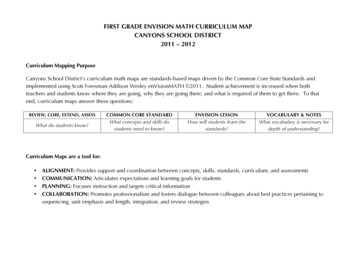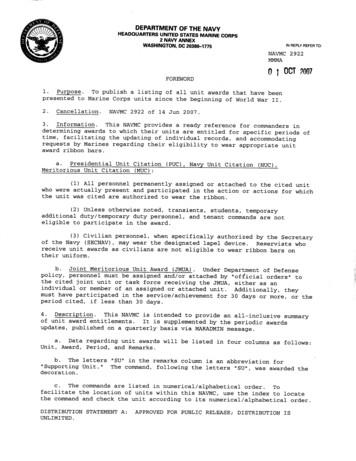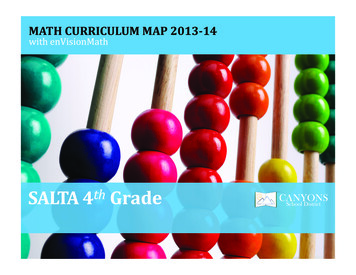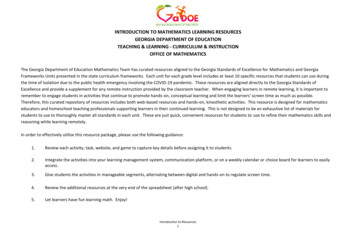
Transcription
FIRST GRADE ENVISION MATH CURRICULUM MAPCANYONS SCHOOL DISTRICT2011 – 2012Curriculum Mapping PurposeCanyons School District’s curriculum math maps are standards-based maps driven by the Common Core State Standards andimplemented using Scott Foresman-Addison Wesley enVisionMATH 2011. Student achievement is increased when bothteachers and students know where they are going, why they are going there, and what is required of them to get there. To thatend, curriculum maps answer these questions:REVIEW, CORE, EXTEND, ASSESSWhat do students know?COMMON CORE STANDARDWhat concepts and skills dostudents need to know?ENVISION LESSONHow will students learn thestandards?VOCABULARY & NOTESWhat vocabulary is necessary fordepth of understanding?Curriculum Maps are a tool for: ALIGNMENT: Provides support and coordination between concepts, skills, standards, curriculum, and assessmentsCOMMUNICATION: Articulates expectations and learning goals for studentsPLANNING: Focuses instruction and targets critical informationCOLLABORATION: Promotes professionalism and fosters dialogue between colleagues about best practices pertaining tosequencing, unit emphasis and length, integration, and review strategies
DRAFT 6/16/2011These maps were collaboratively developed and refined by teacher committees using feedbackfrom classroom teachers, achievement coaches, building administrators, and the office ofEvidence-Based Learning. It is with much appreciation that we recognize the many educators thatcollaborated in the effort to provide these maps for the teachers and students of CSD, ssicaLeeAnneCanyons School District elementary math maps are created by CSD elementary teachersand published by the CSD Office of Evidence-Based ardTorayaVidalWalker
DRAFT 6/16/2011TABLE OF CONTENTSFirst Grade Common Core At-a-Glancepage 1Common Core Standards for Mathematical Practicepage 2General Instructions for the Mappage 3First Grade Year at a Glancepages 4-5First Grade Mappages 6–26First Grade Assessment Continuumpage 27First Grade Vocabulary Listpages 28The Core and More Lesson Checklistpages 29-32Canyons School District elementary math maps are created by CSD elementary teachersand published by the CSD Office of Evidence-Based Learning.
First Grade Math Common Core At-a-GlanceFirst Grade OverviewOperations and Algebraic Thinking(1.OA) Represent and solve problems involving addition andsubtraction. Understand and apply properties of operations and therelationship between addition and subtraction. Add and subtract within 20. Work with addition and subtraction equations.Number and Operations in Base Ten(1.NBT)Four Critical AreasIn Grade 1, instructional time should focus on four critical areas:odeveloping understanding of addition, subtraction, andstrategies for addition and subtraction within 20;odeveloping understanding of whole numberrelationships and place value, including grouping in tensand ones;odeveloping understanding of linear measurement andmeasuring lengths as iterating length units; andoreasoning about attributes of, and composing anddecomposing geometric shapes. Extend the counting sequence. Understand place value. Use place value understanding and properties of operations toadd and subtract.Common Core Practice StandardsMeasurement and Data(1.MD) Measure lengths indirectly and by iterating length units. Tell and write time. Represent and interpret data.Geometry(1.G) Reason with shapes and their attributes.Overarching habits of mind of a productive mathematicalthinker1. Make sense of problems and persevere in solving them6. Attend to precisionReasoning and explaining2. Reason abstractly and quantitatively3. Construct viable arguments and critique the reasoningof othersModeling and using tools4. Model with mathematics5. Use appropriate tools strategicallySeeing structure and generalizing7. Look for and make use of structure8. Look for and express regularity in repeated reasoningCommon Core State Standards Initiative. (2010). Common Core State Standards for Mathematics. Washington, DC: National Governors Association Center for Best Practices and the Council of Chief State School Officers.1
DRAFT 6/15/2011First Grade Math MapThe Common Core Standards for Mathematical PracticeThe Standards for Mathematical Practice describe varieties of expertise that mathematics educators at all levels should seek to develop in their students.These practices rest on important processes and proficiencies with longstanding importance in mathematics education.1. Make sense of problems and persevere in solving them.2. Reason abstractly and quantitatively.3. Construct viable arguments and critique the reasoning of others.5. Use appropriate tools strategically.6. Attend to precision.7. Look for and make use of structure.4. Model with mathematics.8. Look for and express regularity in repeated reasoning.Connecting the Standards for Mathematical Practice to the Standards for Mathematical Content“The Standards for Mathematical Content are a balanced combination of procedure and understanding. Expectations thatbegin with the word “understand” are often especially good opportunities to connect the practices to the content. Studentswho lack understanding of a topic may rely on procedures too heavily. Without a flexible base from which to work, they maybe less likely to consider analogous problems, represent problems coherently, justify conclusions, apply the mathematics topractical situations, use technology mindfully to work with the mathematics, explain the mathematics accurately to otherstudents, step back for an overview, or deviate from a known procedure to find a shortcut. In short, a lack of understandingeffectively prevents a student from engaging in the mathematical practices” (CCSS, 2010).- Common Core State Standards Initiative, 2010: Mathematics Introduction Standards for Mathematical Practice @ Corestandards.orgCanyons School District elementary math maps are created by CSD elementary teachersand published by the CSD Office of Evidence-Based Learning.Mathematics » Introduction » Standards for Mathematical Practice2
DRAFT 6/15/2011First Grade Math MapGeneral InstructionsThis map is a guide for curriculum planning and instruction, put together by your peers (1st grade teachers), based on yourfeedback.Hands-On Math: Please remember that each math concept should be introduced with hands-on learning. Daily use ofmanipulatives should be encouraged. Management and procedures for manipulative use should be taught, practiced, modeled,and reviewed beginning in August and throughout the year. * See the TE for suggestions and lessons for concrete understandingand manipulative use.Patterns. Although patterns are not taught explicitly, students are expected to recognize patterns in numbers.For example: , 6, 7; 3, , 5;7, 8,Continual review. We need to provide an ongoing review of previously taught concepts and skills.EnVision’s Daily Spiral Review works great!Additional CC Lessons. Under the EnVision Lessons, there are some “CC” lessons. These lessons were added to match thecommon core to the first grade lessons we need to teach. These lessons are not found in the hard copies of the EnVision teacherbooks, however digital copies will be available through SuccessNet. Additionally, one hard copy of these materials will beavailable at each school.Supplemental activities and lessons. Please remember, no program is perfect. Please supplement with additional hands-onactivities to meet the needs of individual students as necessary.Common Formative Assessments (CFA). CFA’s are an accountability piece for you as a teacher. The district does not monitorthem. CFA’s are one form of assessment, and the data should be used to help guide and inform your instruction. For example:Which problem(s) did all students get correct? Which problem(s) did a lot of students miss? What concepts need to be retaught? The results of a CFA should not be used as a math “grade” for students.Canyons School District elementary math maps are created by CSD elementary teachersand published by the CSD Office of Evidence-Based Learning.3
DRAFT 6/15/2011First Grade Math MapYear-at-a-Glance 2011-20121st GradeMonthMATH CONCEPTSAugustREVIEWComparing/Ordering Numbers andUnderstanding Addition1. Comparing and OrderingSeptembernumbers using a number line2. Addition up to 921 days3. Addition number sentences4. Adding in any order(commutative property)October17 daysNovember16 daysDecember12 daysTOPICSfromEnVisionTopic 1Topic 2Topic 3M-CBM(M-COMP)Sept. 5-13Subtraction, 5 and 10 Relationships1. Subtraction up to 92. Subtraction number sentences3. Connecting addition andsubtraction4. Finding missing parts 15. Representing numbers on a 10frameTopic 4Topic 5Addition and Subtraction to 121. Addition and subtractionstrategies2. Connecting addition andsubtractionTopic 6Topic 7Geometry1. Recognizing plane and 3-Dshapes2.Composing/decomposing planeshapesCFA and CBMASSESSMENTDATESCFA # 1November 11(Topics 1-5)Topic 8Canyons School District elementary math maps are created by CSD elementary teachersand published by the CSD Office of Evidence-Based Learning.4
DRAFT 6/15/2011First Grade Math MapYear-at-a-Glance 2011-20121st GradeMonthMATH CONCEPTSTOPICSfromEnVisionJanuaryCounting/Number Patterns to 100 andTens and Ones1. Making and using numbers 11-202. Counting patterns on a 100 chart3. Groups of 10 and leftovers4. Expanded formTopic10Topic11Comparing/Ordering Numbers to 100and Measurement1. Comparing using 2. Ordering numbers on a 100 chart3. Estimating and measuring length withnonstandard and standard unitsTopic12Topic14February20 daysMarch18 daysApril16 daysMay21 daysAddition and Subtraction Facts to 181. Addition and subtraction strategies2. Adding 3 numbersTime, Data and Graphing1. Time to the hour and half hour2. Picture graph3. Bar graph4. Tally marksFractions and Adding/Subtracting Tensand Ones1. Making and describing equal parts2. Making halves and fourths3. Adding and subtracting tens from 2digit numbersTopic16Topic17CFA and CBMASSESSMENTDATESCFA #2January 31(Topics 6-8, 10)M-CBM(M-COMP)Jan. 9 -27CFA #3March 30Topics 11, 12, 14,16Topic15Topic18Topic19Topic20CFA #4May 18Topics 15, 17, 18,19, 20M-CBM(M-Comp) May 7th25thCanyons School District elementary math maps are created by CSD elementary teachersand published by the CSD Office of Evidence-Based Learning.5
DRAFT 6/15/2011First Grade Math MapAUGUST (6 days)TOPIC 1 – NUMBERS to 12REVIEW, CORE,EXTEND, ASSESSCOMMON CORESTANDARDENVISION LESSONVOCABULARY & NOTESASSESS&REVIEWReviews KindergartenCore & StudentReadinessReadiness R1-4This is the time for establishing routines, reviewing math conceptsfrom Kindergarten, and assessing students’ needs.REVIEW1.NBT.11-1 Number: 0 to 5REVIEW1.NBT.1, 1.NBT.2,1.NBT.2.b1-2 Number 6 to 10REVIEW1.NBT.11-3 Number: 10, 11, 12REVIEW1.NBT.11-4 Number: Spatial Patterns for Numbers to 9REVIEW1.NBT.11-5 Numbers: Spatial Patterns for Numbers to10REVIEW1.NBT.11-6 Problem Solving.Use Objects*It is recommended that time, odd/even, expanded form, mathsymbols, graphs, and place value be addressed daily.Ten frames (students worked with these in Kindergarten).Include practice of writing numbers.Canyons School District elementary math maps are created by CSD elementary teachersand published by the CSD Office of Evidence-Based Learning.6
DRAFT 6/15/2011First Grade Math MapSEPTEMBER (21 days)TOPIC 2 – COMPARING & ORDERING NUMBERSTOPIC 3 – UNDERSTANDING ADDITIONREVIEW,CORE,EXTEND,ASSESSCOMMON CORE STANDARDENVISION LESSONVOCABULARY & NOTESCOREOperations and Algebraic ThinkingRepresent and solve problemsinvolving addition and subtractionTopic 2Topic 2-3 uses the number line, which is not specifically mentionedin the core until 2nd grade but is a good strategy. It is used in thetopic games.1.OA.1. Use addition and subtractionwithin 20 to solve word problems involvingsituations of adding to, taking from, puttingtogether, taking apart, and comparing, withunknowns in all positions, e.g., by usingobjects, drawings, and equations with asymbol for the unknown number torepresent the problem.Interactive math story p.29GTopic Opener p. 29Lesson 2-1 p.31AComparing Two Numbersvocabulary: more, greater than, fewer, less thanCORE1.NBT.32-2 Ordering ThreeNumbersvocabulary: least, greatest, betweenEXTENDExtends 1.NBT.32-3 Ordering Numbers to12 with a Number LineTopic 2-3 uses the number line; not specifically mentioned in thecore but is a good strategy. It is used in the topic games and topictest.vocabulary: before, afterEXTENDExtends 1.NBT.32-4 Problem Solving Act ItOut!Canyons School District elementary math maps are created by CSD elementary teachersand published by the CSD Office of Evidence-Based Learning.7
DRAFT 6/15/2011COREFirst Grade Math Map1.0A.1Work with addition and subtractionequations.1.OA.7. Understanding the meaning of theequal sign, and determine if equationsinvolving addition and subtraction are trueand false. For example, which of thefollowing equations are true and which arefalse? 6 6, 7 8-1,5 2 2 5, 4 1 5 2.Topic 3Interactive Math Storyp.49G Beach CountTopic OpenerUnderstanding Additionp.493-1 Addition: Making 6-7vocabulary: in all, inside, outsidevocabulary: part, whole, doubleCORE1.0A.13-2 Addition: Making 8CORE1.0A.13-3 Addition: Making 9CORE1.OA.1, 1.OA.7, 1.OA.83-4 Addition: IntroducingAddition NumberSentencesCORE1.OA.1, 1.OA.7CC-1Introducing AdditionExpressions and NumberSentencesCORE1.0A.13-5 Addition: StoriesAbout Joiningvocabulary: joinCORE1.0A.3Understand and apply properties ofoperations and the relationshipbetween addition and subtraction.3-6 Addition: Adding inAny Ordervocabulary: order and addendvocabulary: add, sum, addition sentence, plus, equals1.OA.3. Apply properties of operations asstrategies to add and subtract. Examples: If8 3 11 is known, then 3 8 11 is alsoCanyons School District elementary math maps are created by CSD elementary teachersand published by the CSD Office of Evidence-Based Learning.8
DRAFT 6/15/2011First Grade Math Mapknown. (Commutative property ofaddition.) To add 2 6 4, the second twonumbers can be added to make a ten, so2 6 4 2 10 12. (Associative property ofaddition.)CORE1.0A.13-7 Problem Solving UseObjectsASSESSM-CBM TESTINGTESTS of EARLYNUMERACYADMINISTERED one-on-one BY DISTRICT TESTING TEAM DURINGCBM TESTING: SEPTEMBER 5-13Canyons School District elementary math maps are created by CSD elementary teachersand published by the CSD Office of Evidence-Based Learning.9
DRAFT 6/15/2011First Grade Math MapOCTOBER (17 days)TOPIC 4 – UNDERSTANDING SUBTRACTIONTOPIC 5 – FIVE AND TEN RELATIONSHIPSREVIEW,CORE,EXTEND,ASSESSCOMMON CORE STANDARDENVISION LESSONVOCABULARY & NOTESCORE1.0A.1 (see September)Operations and Algebraic ThinkingUnderstand and apply properties of operationsand the relationship between addition andsubtraction.Topic 4Introduction, Math Story, Game (opt)4-1 Finding Missing Parts of 6 and 7vocabulary: missing part1.0A.4 Understand subtraction as an unknown-addendproblem. For example, subtract 10-8 by finding thenumber that makes 10 when added to 8.Work with addition and subtraction equations.1.0A.8 Determine the unknown whole number in anaddition or subtraction equation relating three wholenumbers. For example, determine the unknownnumber that makes the equation true in each of theequations8 ? 11, 5 - 3, 6 6 .Of course, if you need additional daysbeyond the month of October, please takethe time needed for your students to need tobuild the foundational understandings inTopic 4 and 5.CORE1.0A.11.0A.41.0A.6 1.0A.84-2 Finding Missing Parts of 8CORE1.0A.11.0A.41.0A.6 1.0A.84-3 Finding Missing Parts of 9CORE1.0A.11.0A.41.0A.61.0A.7This unit may present some challenges, butif you go slow and easy, and usemanipulatives before moving to thesymbolic level, student understanding willincrease.Consider supplementing with Investigationslessons for additional concrete learning.Another source: Math Their Wayhttp://www.center.edu/MathTheirWay.shtml4-4 Introducing Subtraction Numbervocabulary: subtract, difference, subtractionCanyons School District elementary math maps are created by CSD elementary teachersand published by the CSD Office of Evidence-Based Learning.10
DRAFT 6/15/2011First Grade Math MapSentencesCORE1.OA.1, 1.OA.4CC-2Introducing Subtraction Expressionsand Number SentencesCORE1.0A.11.0A.41.0A.6 1.0A.84-5 Stories About SeparatingCORE1.0A.11.0A.41.0A.6 1.0A.84-6 Stories About ComparingCORE1.0A.11.0A.41.0A.6 1.0A.84-7 Connecting Addition andSubtractionCORE1.OA.7, 1.OA.8CC-3Connecting Models and SymbolsCORE1.0A.14-8 Problem Solving Use ObjectsCOREOperations and Algebraic ThinkingAdd and subtract within 20.Topic 5Intro to Topic 5, Story, Game (opt.)5-1 Representing Numbers on a TenFrame1.0A.6 Add and subtract within 20, demonstratingfluency for addition and subtraction within 10. Usestrategies such as counting on; making ten (e.g., 8 6 8 2 4 10 4 14); decomposing a numberleading to a ten (e.g., 13 - 4 13 - 3 - 1 10 - 1 9);using the relationship between addition andsubtraction (e.g., knowing that 8 4 12, one knows12 - 8 4); and creating equivalent but easier orknown sums (e.g., adding 6 7 by creating the knownequivalent 6 6 12 1 13).CORE1.0A.6sentence, minus sign, equal signvocabulary: compare5-2 Recognizing Numbers on a Ten-Canyons School District elementary math maps are created by CSD elementary teachersand published by the CSD Office of Evidence-Based Learning.11
DRAFT 6/15/2011First Grade Math MapFrameCORE1.0A.61.0A.45-3 Parts of 10CORE1.0A.11.0A.8COREMeasurement and DataRepresent and interpret data.5-4 Finding Missing Parts of 105-5 Problem Solving Make a Table1.MD.4 Organize, represent, and interpret data withup to three categories; ask and answer questions aboutthe total number of data points, how many in eachcategory, and how many more or less are in onecategory than in another.Canyons School District elementary math maps are created by CSD elementary teachersand published by the CSD Office of Evidence-Based Learning.12
DRAFT 6/15/2011First Grade Math MapNOVEMBER (16 days)TOPIC 6 – ADDITION FACTS TO 12TOPIC 7 – SUBTRACTION FACTS TO 12REVIEW, CORE,EXTEND, ASSESSCOMMON CORESTANDARDENVISION LESSONVOCABULARY & NOTESASSESSCFA #1Topics 1-5Completed by November 11CORE1.OA.3Operations andAlgebraic ThinkingAdd and subtractwithin 20.Topic 66-1 Adding with 0,1,2: Intro withinteractive story, game.Core requires students to add and subtract within 20 and demonstratefluency adding and subtracting within 10. Envision lesson contain 2single digits with regrouping preparing them for no regrouping.Although these lessons begin to become more abstract, ensuringstudent understanding at the concrete/symbolic level is critical tostudent math achievement. Concrete understanding(developed through the use of manipulatives) increases mental mathand students’ flexibility in thinking.1.OA.5. Relate countingto addition andsubtraction (e.g., bycounting on 2 to add 2).1.OA.6, 1.OA.7CORE1.OA.6, 1.OA.86-2 Addition: DoublesCORE1.OA.6, 1.OA.86-3 Addition: Near DoublesCORE1.OA.6, 1.OA.86-4 Addition: Facts with 5 on a TenFrameCORE1.OA.6, 1.OA.86-5 Addition: Making 10 on a TenFrameCORE1.OA.16-6 Problem Solving Draw a Pictureand Write a Number Sentencevocabulary: near doubleCanyons School District elementary math maps are created by CSD elementary teachersand published by the CSD Office of Evidence-Based Learning.13
DRAFT 6/15/2011First Grade Math MapCORE1OA.1, 1.OA.5,1.OA.6Topic 77-1 Subtraction: Subtracting with0,1,2: Introduction with Interactivestory and game.CORE1.OA.1, 1.OA.4,1.OA.6, 1.OA.87-2 Subtraction: Thinking AdditionCORE1.OA.1, 1.OA.4,1.OA.6, 1.OA.87-3 Subtraction: Thinking Additionto 8 to SubtractCORE1.OA.1, 1.OA.4,1.OA.6, 1.OA.87-4 Thinking Addition to 12 toSubtractCORE1.OA.17-5 Problem Solving Draw a Pictureand Write a Number Sentencevocabulary: 2 less than, 1 less than, 0 less thanCanyons School District elementary math maps are created by CSD elementary teachersand published by the CSD Office of Evidence-Based Learning.14
DRAFT 6/15/2011First Grade Math MapDECEMBER (12 days)TOPIC 8 – GEOMETRYREVIEW, CORE,EXTEND, ASSESSCOMMON CORE STANDARDENVISION LESSONVOCABULARY & NOTESCOREGeometryReason with shapes and theirattributes.Topic 8Topic 8 - InteractiveMath Story, HomeSchool Connection,Game8-1 Identifying PlaneShapesvocabulary: plane shapes, triangle, rectangle, circle, square1.G.1. Distinguish between definingattributes (e.g., triangles are closedand three-sided) versus nondefining attributes (e.g., color,orientation, overall size); build anddraw shapes to possess definingattributes.CORE1.G.18-2 Properties of PlaneShapesCORE1.G.2CC-4Building with ShapesCOREGeometryReason with shapes and theirattributes.8-3 Making NewShapes from ShapesThere are only 10 lessons and 12 instructional days this month. Considerusing December to review prior concepts.Topic 9 (Patterning) is not 1st grade core, please skip.vocabulary: sort, side, corner1.G.2. Compose two-dimensionalshapes (rectangles, squares,trapezoids, triangles, half-circles,and quarter-circles) or threedimensional shapes (cubes, rightrectangular prisms, right circularcones, and right circular cylinders)to create a composite shape, andcompose new shapes from theCanyons School District elementary math maps are created by CSD elementary teachersand published by the CSD Office of Evidence-Based Learning.15
DRAFT 6/15/2011First Grade Math Mapcomposite shape.CORE1.G.28-4Breaking Apart Shapesto Make ShapesEXTENDExtends 1.G.28-8 Problem-SolvingCORE1.G.18-9 Identifying SolidFiguresCORE1.G.18-10Flat Surfaces andCornersCORE1.G.2CC-5Building with SolidFiguresCORE1.G.18-11 Sorting SolidFiguresvocabulary: solid figures, cube, rectangular prism, sphere, cylinder, coneCanyons School District elementary math maps are created by CSD elementary teachersand published by the CSD Office of Evidence-Based Learning.16
DRAFT 6/15/2011First Grade Math MapJANUARY (20 days)TOPIC 10 – COUNTING AND NUMBER PATTERNS TO 100TOPIC 11 - TENS AND ONESREVIEW, CORE,EXTEND, ASSESSCOMMON CORESTANDARDENVISION LESSONVOCABULARY & NOTESASSESSM-CBM TESTINGM-COMPJanuary 9-27CORENumber and Operationsin Base TenTopic 10Introduction: Interactive Math Story pg. 261Gand Topic 10 Opener on pg. 261.Note: There are 20 instructional days this month and only12 lessons, consider using the extra days to reteach thesenew concepts using concrete lessons (see Envision’s TE,Investigations, and Math Their Wayhttp://www.center.edu/MathTheirWay.shtml for additionallessons).Understand place value.1.NBT.2b Understand thatthe two digits of a two-digitnumber represent amounts oftens and ones. Understandthe following as specialcases: The numbers from 11to 19 are composed of a tenand one, two, three, four,five, six, seven, eight, or nineones.*Lessons 10-6, 10-7, 10-8 are not common core aligned.Please skip those lessons, as they are 2nd grade content.CORE1.NBT.2, 1.NBT.2a,1.NBT.2b10-1 Number: Making Numbers 11 to 20Supplement as necessary.CORE1.NBT.1, 1.NBT.210-2 Number: Using Numbers 11 to 20Supplement as necessary.CORE1.NBT.2c The numbers 10,20, 30, 40, 50, 60, 70, 80,90 refer to one, two, three,four, five, six, seven, eight, ornine tens (and 0 ones).10-3 Patterns: Counting by 10s to 100Canyons School District elementary math maps are created by CSD elementary teachersand published by the CSD Office of Evidence-Based Learning.17
DRAFT 6/15/2011First Grade Math MapCORE1.NBT.110-4 Counting Patterns on a Hundred ChartCORE1.NBT.110-5Using Skip CountingCORE1.NBT.110-9Problem Solving: Look for a PatternCORE1.NBT.11.NBT.2Topic 11Introduction, Math Story, Game11-1 Counting with Groups of 10 andLeftoversCORE1. NBT.1, 1.NBT.2, 1.NBT.2a,1.NBT.2.c11-2 Number: Counting with Groups of 10and Leftoversvocabulary: tensCORE1. NBT.1, 1.NBT.2, 1.NBT.2a,1.NBT.2b, 1.NBT.2.c11-3 Number: Numbers Made with Tensvocabulary: ones, digitCORE1.OA.7, 1.NBT.1, 1.NBT.211-4 Expanded Form* This lesson goes beyond the scope of the core for thisconcept. Please teach the basic concept, but use theextensions provided in this lesson at your discretion.CORE1.NBT.2, 1.NBT.2a11-5 Number: Ways to Make Numbersvocabulary: break apart a ten* This lesson goes beyond the scope of the core for thisconcept. Please teach the basic concept, but use theextensions provided in this lesson at your discretion.CORE1.NBT.2, 1.NBT.2.a11-6 Problem Solving Make an Organized ListASSESSCFA #2Topics 6, 7, 8, 10Completed by January 31Canyons School District elementary math maps are created by CSD elementary teachersand published by the CSD Office of Evidence-Based Learning.18
DRAFT 6/15/2011First Grade Math MapFEBRUARY (20 days)TOPIC 12 – COMPARING AND ORDERING NUMBERS TO 100TOPIC 14 - MEASUREMENTREVIEW, CORE,EXTEND, ASSESSCOMMON CORE STANDARDENVISION LESSONVOCABULARY & NOTESCORE1.NBT.4, 1.NBT.5, 1.NBT.6Topic 12Introduction to Topic 12, Math Story, Game 121 1 More, 1 Less, 10 More, 10 Lessvocabulary: 1 more, 1 less, 10 more, 10lessTopic 13 (Counting Money) is not 1st gradecore. Please skip these lessons.CORE1.NBT.2, 1.NBT.412-2 Making Numbers on a Hundred ChartCORE1.NBT.312-3 Comparing Numbers with , , vocabulary: equal to ( )CORE1.NBT.312-4 Ordering Numbers with a Hundred ChartModify lesson to core standardsCORE1.NTB.312-5 Number Line Estimationvocabulary: closest tenCORE1.NTB.312-6 Before, After, and BetweenCORE1.NTB.312-7 Ordering Three NumbersCORE1.MD.312-8 Problem Solving Make an Organized ListCOREMeasurement and DataMeasure lengths indirectly and byiterating length units.Topic 14Topic 14 Interactive Math Story and Game1.MD.1. Order three objects by length;compare the lengths of two objectsCanyons School District elementary math maps are created by CSD elementary teachersand published by the CSD Office of Evidence-Based Learning.19
DRAFT 6/15/2011First Grade Math Mapindirectly by using a third object.CORE1.MD.114-1 Comparing and Ordering by LengthCORE1.MD.1CC-6Indirect MeasurementCOREMeasurement & DataMeasure lengths indirectly and byiterating length units.14-2 Using Units to Estimate and MeasureLengthvocabulary: longest, shortestvocabulary: estimate, measure1.MD.2. Express the length of an object asa whole number of length units, by layingmultiple copies of a shorter object (thelength unit) end to end; understand that thelength measurement of an object is thenumber of same-size length units that spanit with no gaps or overlaps. Limit tocontexts where the object being measuredis spanned by a whole number of lengthunits with no gaps or overlaps.CORE1.MD.2CC-7Big and Small UnitsCORE1.MD.214-3 Problem Solving: Use ReasoningCORE1.MD.214-4 Feet and InchesCORE1.MD.214-5 CentimetersCanyons School District elementary math maps are created by CSD elementary teachersand published by the CSD Office of Evidence-Based Learning.20
DRAFT 6/15/2011First Grade Math MapMARCH (18 days)TOPIC 16 – ADDITION FACTS TO 18TOPIC 17 – SUBTRACTION FACTS TO 18REVIEW, CORE,EXTEND, ASSESSCOMMON CORE STANDARDENVISION LESSONVOCABULARY & NOTESCOREOperations and Algebraic Thinking:Topic 16Introduction.Interactive Math Storypg. 479G and Topic Openerpg. 479 and Game pg. 480.For your consideration: 1stgrade core requiresaddition/subtraction up to19.Add and subtract within 20.1.OA.6 Add and subtract within 20, demonstrating fluency foraddition and subtraction within 10. Use strategies such as countingon: making ten (e.g., 8 6 8 2 4 10 4 14); decomposing a numberleading to a ten (e.g., 13-4 13-3-1 10-1 9); using the relationshipbetween addition and subtraction (e.g. knowing that 8 4 12 oneknows 12-8 4); and creating equivalent but easier or known sums9e.g., adding 6 7 by creating the known equivalent6 6 1 12 1 13).*Topic 15 (Time) is movedto May.CORE1.OA.616-1 Addition: DoublesCORE1.OA.616-2 Addition: Doubles Plus 1vocabulary: doubles plus 1CORE1.OA.616-3 Addition: Doubles Plus 2vocabulary: doubles plus 2CORE1.OA.616-4 Problem Solving: Two-QuestionProblemsNumber and Operations in Base Ten16-5 Addition: Making 10 to Add 9COREUse place value understanding and properties of operations to addand subtract.1.NBT.4 Add within 100, including adding a two-digit number and aone-digit number, and adding a two-digit number and a multiple of10, using concrete models or drawings and strategies based on placevalue, properties of operations, and/or the relationships betweenaddition and subtraction; relate the strategy to a written method andCanyons School District elementary math maps are created by CSD elementary teachersand published by the CSD Office of Evidence-Based Learning.21
DRAFT 6/15/2011First Grade Math Mapexplain the reasoning used. Understand that in adding two-digitnumbers, one adds tens and tens, ones and ones; and sometimes it isnecessary to compose a ten.CORECORE1OA. 1, 1.OA.6, 1.OA.816-6 Addition: Making 10 to Add 8Operations and Algebraic Thinking16-7 Addition: Adding Three NumbersRepresent and solve problems involving addition and subtraction.1.OA.2 Solve word problems that call for addition of three wholenumbers whose sum is less than or equal to 20, e. g., by using objects,drawings, and equations with a symbol for the unknown number torepresent the problem.1.OA.3CORE1.OA.2, 1.OA.3CC-8Word Problems with Three AddendsCORE1.NBT.4,1.OA.3 and 1.OA.4Topic 17Interactive Math Story pg. 515G, TopicOpener pg. 515, and Math Game 516.CORE1NBT
DRAFT 6/15/2011 First Grade Math Map Canyons School District elementary math maps are created by CSD elementary teachers and published by the CSD Office of Evidence-Based Learning. 5 Year-at-a-Glance 2011-2012 1st Grade Month MATH CONCEPTS TOPICS from EnVision CFA and CBM ASSESSMENT DATES January Counting/Number Patterns to 100 and










